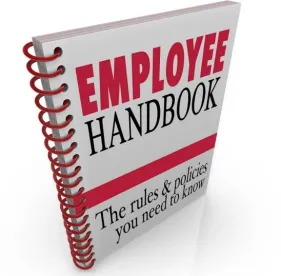In a recent decision, a National Labor Relations Board (“NLRB”) Administrative Law Judge (“ALJ”) ruled that Quicken Loans’s (the “Company”) Detroit, Michigan branch (along with five related entities) violated the National Labor Relations Act (“NLRA”) by using and disseminating an employee manual in its non-union workplace that the ALJ concluded interfered with employees’ rights under the NLRA. This was yet another case in which the NLRB took aim against Quicken Loans for adopting work rules and/or policies that an ALJ found would “chill” non-unionized employees in the exercise of their rights under the NLRA. As we previously discussed in another post, in March 2016, the NLRB found that the Company’s branch in Scottsdale, Arizona violated the NLRA by implementing unlawful work rules after one of its bankers used profanity and complained about a client in an office restroom.
The most recent case revolved around a 238-page employee manual referred to as the “Big Book.” In Quicken Loans Inc. et al. and Hugh MacEachern, Case Number 07-CA-145794, an ALJ found a number of provisions in the Big Book unlawfully interfered with employees’ rights to engage in concerted activities concerning their terms and conditions of employment. Although Quicken Loans has vowed to appeal the April decision to the Board in Washington for setting a “dangerous precedent,” the decision in reality follows a long line of NLRB precedents that have taken a buzz-saw to employment policies and agreements where it believes they may interfere with employees’ protected Section 7 activity (i.e., activity that implicates employees’ right to form, join or assist labor organizations or collectively bargain or act for their mutual aid and protection). In this latest decision, the ALJ reviewed a number of the Big Book’s rules, ultimately finding many, but not all, to be unlawful on account of being “overbroad,” which the ALJ explained means is a rule that is broader than necessary to protect the employer’s legitimate interest and that “employees would reasonably interpret . . . to encompass protected activities” under the NLRA. We list and discuss some of these rules below to shed light on what the NLRB considers to be unlawful interference with employees’ rights, as opposed to a lawful work rule.
Found to be Unlawful Rules:
-
“This book contains confidential information that must not be disclosed outside the Company or used for purposes other than for the Company’s legitimate business purposes. This book or any of its contents may not be reproduced or disseminated to anyone not employed by the Company.” The ALJ concluded this rule was overbroad and would be seen by employees as prohibiting actions protected by the NLRA because there was no way for an employee to know what portions of the Big Book were confidential. Moreover, a blanket prohibition on dissemination of “any of [the Big Book’s] contents” was overbroad because the Big Book discussed matters relating to the terms and conditions of employment.
-
“Think before you Tweet. Or post, comment or pin. What you share can live forever. If it doesn’t belong on the front page of the New York Times, don’t put it online.” The ALJ found this to be a violation of the NLRA because an employee considering this rule would reasonably feel chilled from expressing negative, but protected, information about the Company, which is protected by the NLRA.
-
“The Company recognizes that team members may desire to display mementos pertaining to family or other personal items. However, nothing can be displayed that is, or could be deemed to be, harmful or offensive to a reasonable person and his or her system of beliefs.” The ALJ concluded this rule was unlawful because a reasonable employee would “think twice” in the face of this rule before displaying pro-union mementos and thus would see it as a prohibition on union related activity.
-
“The Company’s buildings, offices, common areas . . . are to be used only for conducting Company business and transactions, and for no other purpose.” The ALJ found this rule was unlawful because an employee would reasonably understand it to bar solicitation and other protected activity at times and in places where such activities are protected by the NLRA.
-
“You shall not photograph or record through any means the Company’s operations, systems, presentations, communications, voicemails, or meetings.” The ALJ found that this policy was unlawful because employees would likely understand this to prohibit protected activity, such as the recording of a meeting held to discuss wages and other terms and conditions of employment.
-
“[You may not use] Company Resources to engage in inappropriate acts that exhibit conduct that is not in the best interests of the Company, its clients, or Team Members”; “[You may not use a] signature line that contain religious, political, sexual or other inappropriate content.” The ALJ found the first rule was overbroad and unlawfully interfered with employees’ rights because an employee would believe that using email to harshly criticize the terms and conditions of employment would be considered “inappropriate” action “not in the best interest of the Company.” Similarly, the ALJ held that the second rule was unlawful and interfered with employees’ statutory rights because an employee would likely believe that “inappropriate content” would include speech protected by Section 7 of the NLRA.
-
“[You may not] “Communicat[e] with the media without express authorization from the Corporate Communications Team.” The ALJ found this to be a “straightforward” violation of the NLRA because employees have a right to communicate with the media on subjects relating to their terms and conditions of employment, including but not limited to formation of and membership in and representation by unions.
Found to be Lawful Rules:
-
“From time to time, team members may have access to private Company information, for example, information about financial performance, strategy, forecasts, etc. Such information is confidential, any may not be shared with people or entities outside the Company—including members of the media.” The ALJ said this provision was lawful because, based on the explanation of the type of information covered by the rule, employees would reasonably understand that the rule related to their employers’ interest in the security of their proprietary information and not to information protected by Section 7.
-
Unacceptable conduct includes: “Harassment: verbal, physical, or visual harassment of a team member, client, consultant, business partner, vendor or any other person associated with the Company.” The ALJ stated that this was lawful because employees have a right to a workplace free of unlawful harassment.
-
“You acknowledge and agree that: (a) all documents . . . and (b) all office equipment and supplies . . . are and shall remain the property of the Company . . .” The ALJ held that this was lawful because it included no language prohibiting the sharing, copying or dissemination of employee lists or other information that is described as company property.
-
“Transmission of Sensitive Information. Sensitive information must not be transmitted over the Internet without prior management approval.” The ALJ said that this was lawful because the Big Book defined Sensitive Information and provided 21 examples of such information. Thus, it would be unreasonable for an employee to conclude that he was precluded by this work rule from transmitting Section 7 information.
-
“Personal Electronic Devices. Approval from management . . . is needed before any Sensitive Company information is stored on a personal electronic device, and the amount of information stored should be kept to a minimum. Special protection needs to be enabled on each device to ensure that the stored information is kept secure.” The ALJ found that an employee would not likely construe “sensitive” information to include information protected by Section 7 activity.
Based on the findings, the ALJ ordered Respondents to cease and desist from maintaining the overly broad work rules. Respondents, however, had already done so: on December 4, 2015, by email notice sent to all employees, the Respondents rescinded all versions of the Big Book, effective immediately.
This case is yet another example of the NLRB’s continued broad view of what constitutes “concerted protected activity,” “work rules” and unlawful activity under the Act. Because the distinction between an overbroad and lawful work rule is not always clear-cut, any employer subject to the Act (one whose company affects commerce) should carefully review its various agreements and policies, whether in an nondisclosure agreement, offer letter, handbook, manual, separation agreement, or the like to ensure that they do not contain rules that would potentially chill union-related activities. Taking a proactive approach will put employers in the best possible position if they have to face scrutiny from the NLRB.




 />i
/>i

